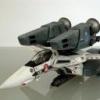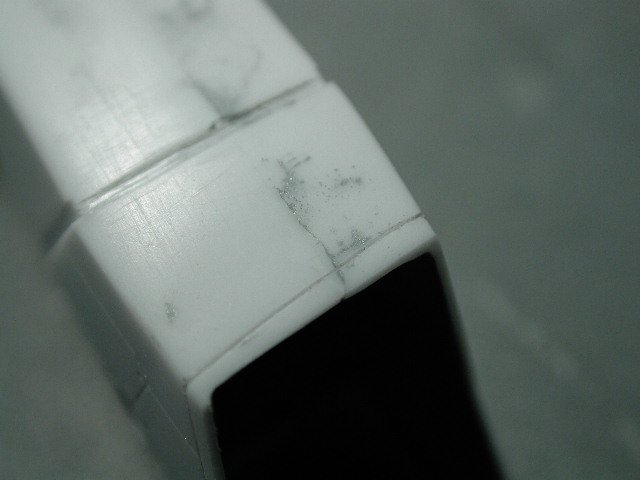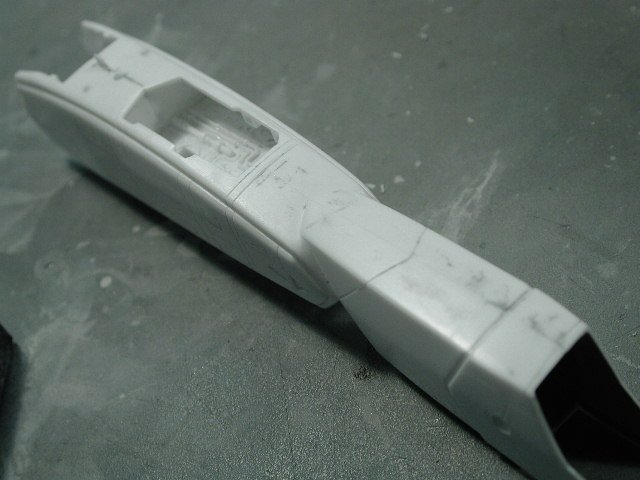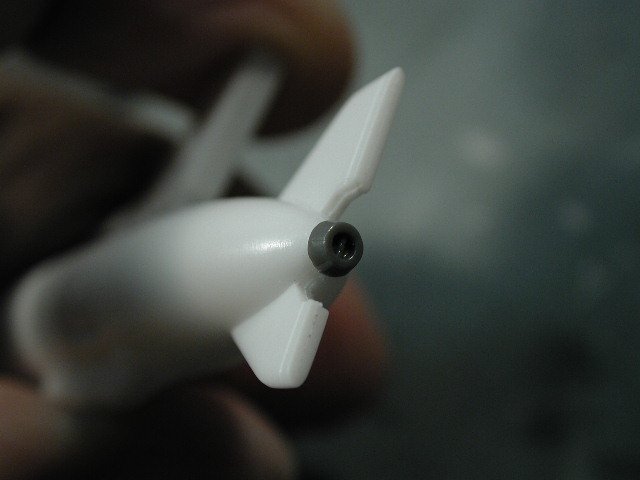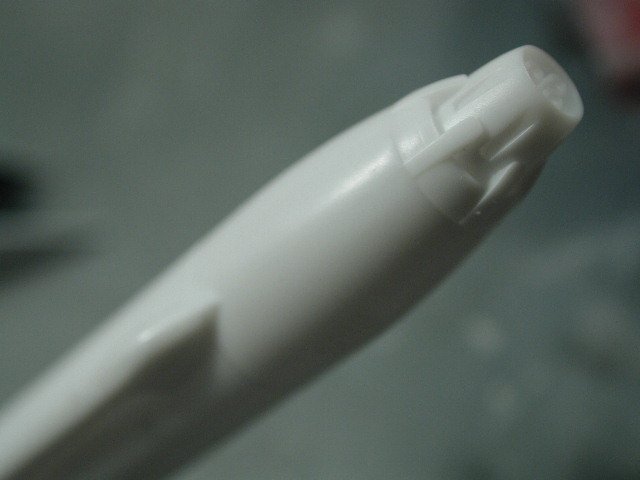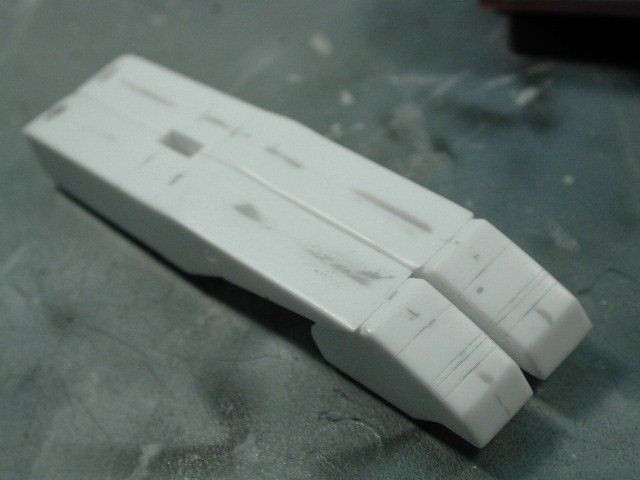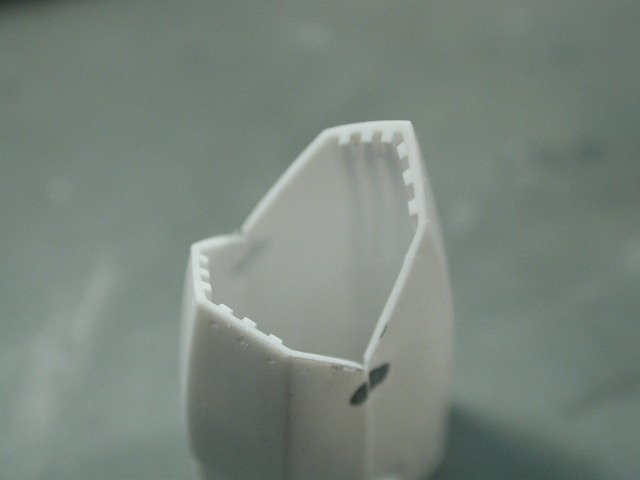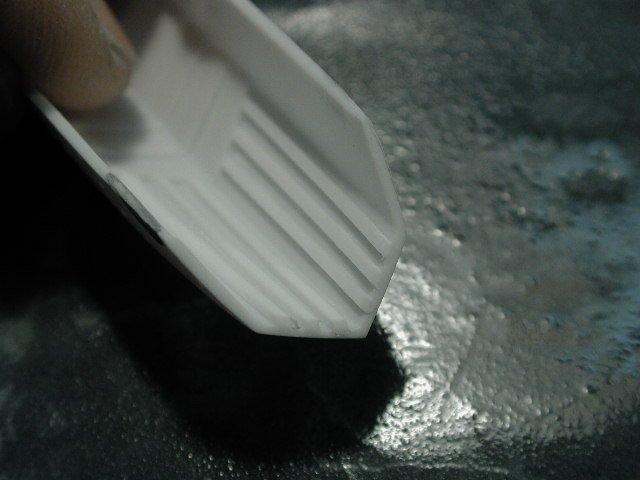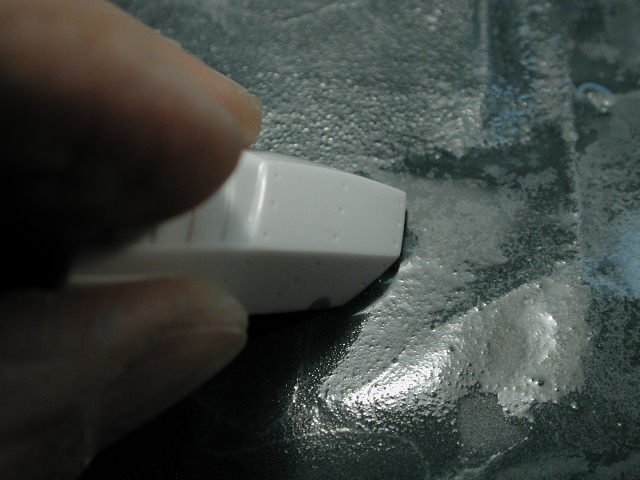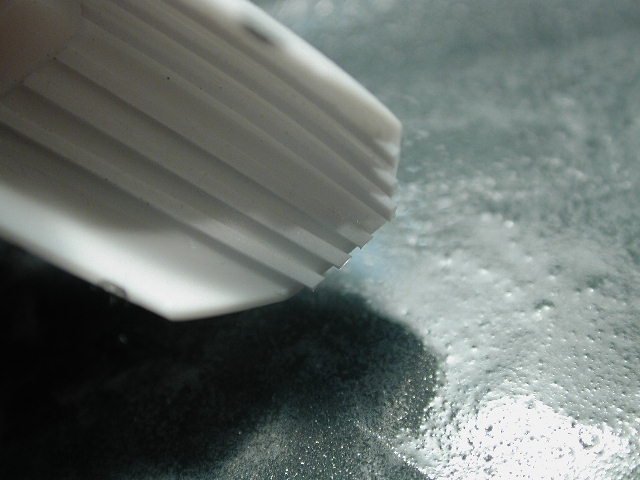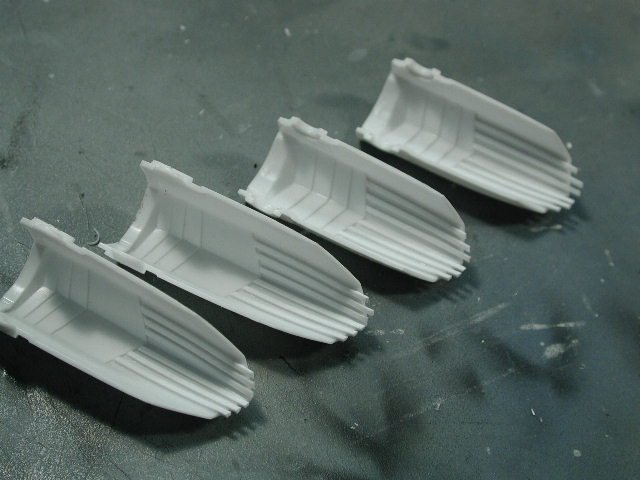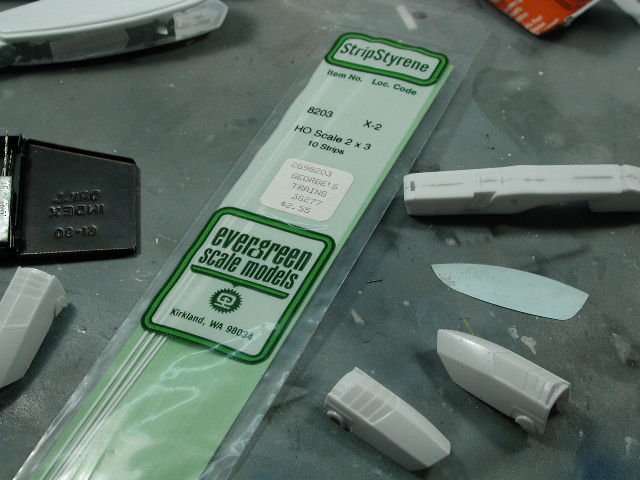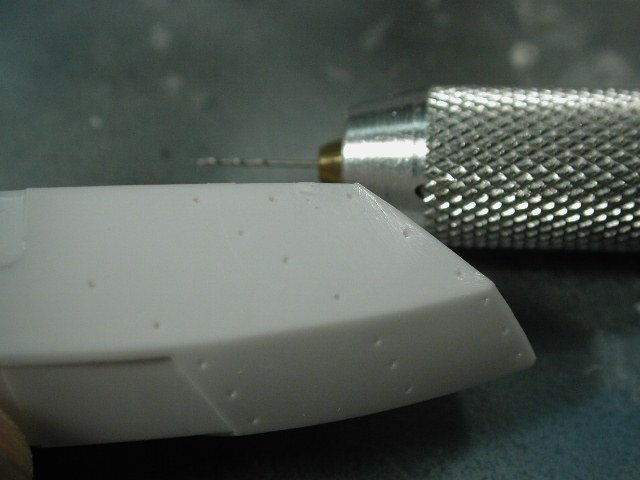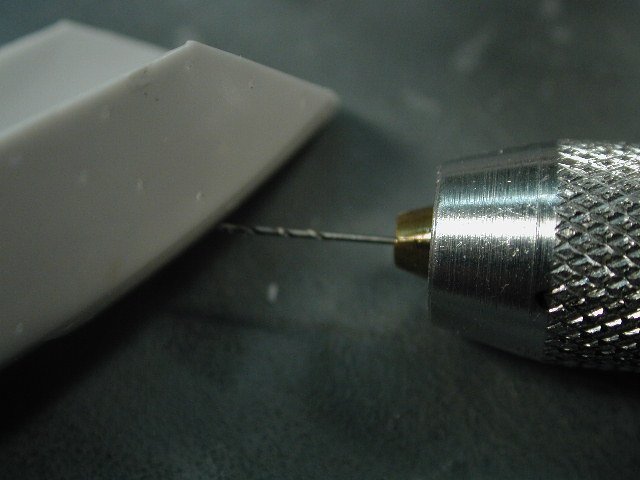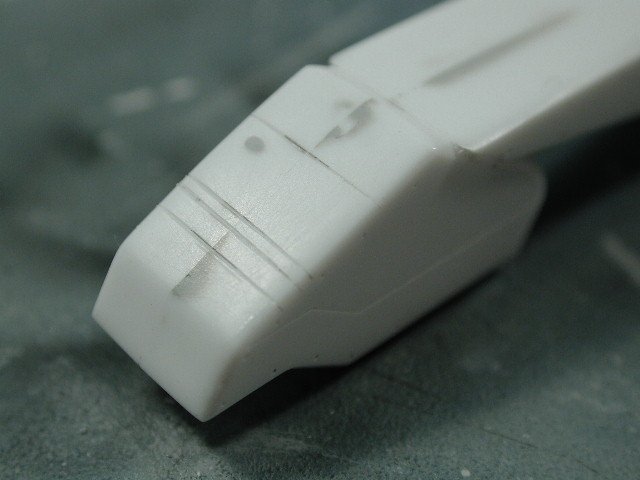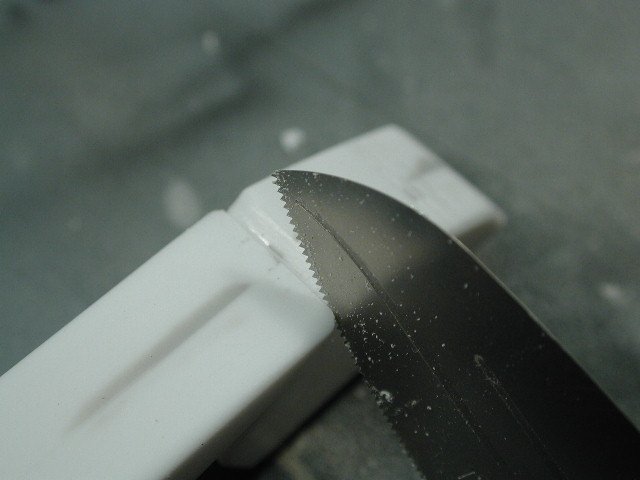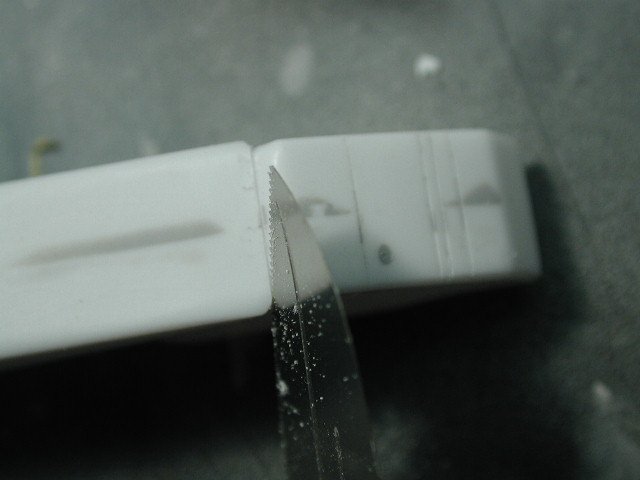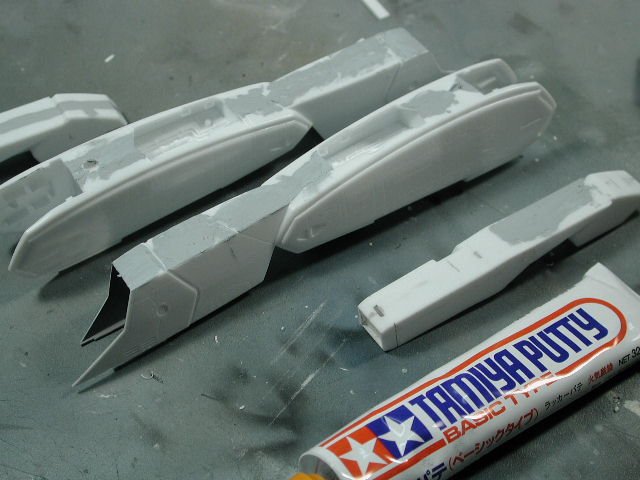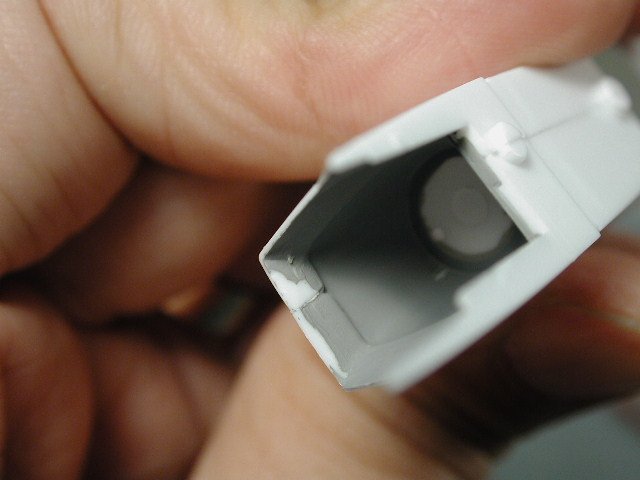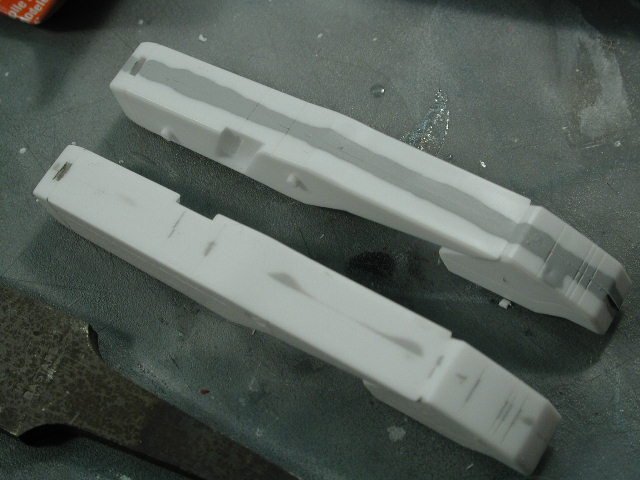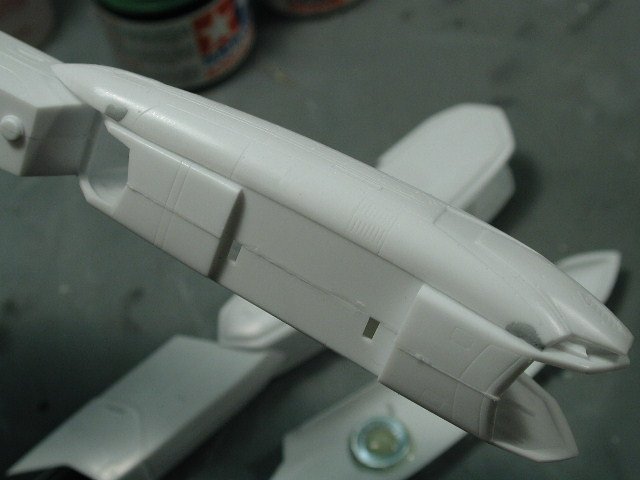-
Posts
4276 -
Joined
-
Last visited
Content Type
Profiles
Forums
Events
Gallery
Everything posted by wm cheng
-
Here's a closeup of the front edge of the intakes on the lower surface. I filled in and sanded away the old panel lines that do not match up. I have re-scribed a new line that matches up across the seam. Its not really parallel with the front edge of the intakes since I thought it be more important to match up to the panel lines on the sides of the intakes (and they are not symetrical in width). You can see a smudge of putty on the left side - I guess that was a minor sink hole that he putty did its job in filling. It is curious though, there seems to be a bunch of tiny little pits (the small grey dots) around the seam. I finally got a new tube of Tamiya putty (my previous one lasted me 5 years! - it actually dried up when the tube developed cracks) and the new tube was very liquidy - I think the solvent and the putty didn't mix or separated. I am guessing that this liquid pitted the plastic while it was drying (kind of like plastic cement) I am hoping that the grey dots mean that they are filled. I guess I will find out when I do a light coat of flat white as primer soon.
-
Here's the leg with most of the putty sanded off - its really important to get rid of the seams along these halves. You can see the panel lines are re-scribed back in.
-
I thought I add a little detail to the end of the gunpod, the original just butte ends, I glued on a little tiny minus mold vent from those wave option parts (same ones I used earlier on in the thread for the pilot's seat) I think this nice caps off the end of the gun.
-
Again I am making sure that the seam on the gunpod is totally gone, I am almost polishing it since that Alcad metalizer isn't too forgiving.
-
-
Here's the assembly together - I'm glad I took the time to add the strips, it make the end profile a bit more interesting. You can see a dab of Mr. Surfacer1000 at the sprue connection points yet to be sanded off. I want to make sure these babies are completely blemish free - since that Alclad metalizer stuff will transmit the slightest imperfections through.
-
The edges should be flush with the ends of the tailcone and look molded in instead of added on - I thought it worked out pretty well.
-
On wet coarse (100grit) sanding film, I dragged the tail cone with the slightly long strips along the surface. I always drag in one direction (right to left - in this picture) so that the strips will always be pressed against the tailcone - I didn't drag against the glue (you don't want to accidentally pull the strips away from the tailcone)
-
-
A few more hours today - just a ton of sanding and re-sanding. David, man, those AMT/Ertl Star Trek kits sure bring back nightmares!! They must be one of the worst kits in history - did you ever build the "Airwolf" kit of the Bell 222 by AMT/Ertl - just about made me swore off models all together! Its easier to leave the styrene strips long so you can hold on to them while you're gluing them in place. Then snip them a tad long (we'll sand them down later) I've decided to only do the strips to the top and bottom.
-
Exactly what Grayson is saying. Man, when I switched from testors to Tamiya putty - it was like night and day - its worth the little extra for the Tamiya putty - but think of how much time and aggravation you'd save. Then I discovered Mr. Surfacer - and wow! for small seams its just beautiful. I'd start with a 200 grit sanding film (sanding wet) and then work your way up to 600/800 grit - becareful not to use too coarse of a paper especially on soft plastics. I am going through sanding process right now with the VF-0 to get rid of seams, you might want to hop on over to page 10 of my VF-0 thread. I always try to run my nails across the seam slowly, if it catches on anything, then keep sanding away!! At least your primer is doing the job of showing you where you still have to fill and sand. I almost always have to go back and repair or re-fill or sand some part after the first initial light coat of primer or paint. Good Luck - sorry can't help you with the bra or shoes
-
These are the little styrene strips that you can buy at most model train stores - I'm too lazy to cut even strips from a sheet of styrene so I bought the ones already cut . Isn't civilization great I plan on gluing these to the insides of the nozzles to create that ribbed look. I'm sure Hasegawa will come out with a photo-etched part for this shortly after we make these ourselves But until then... Hopefully there will be more tomorrow.
-
Here's a shot when they are done. I did them before sanding the edges and the sprue attachment points since I didn't want to accidentaly sand away the very faint depressions away marking where I should drill.
-
I am using the pin vise to drill out the depressions that Hasegawa tried to make in the side of the afterburning cans. Its really easy since they already marked them - just not deep enough. The hardest part is not going through the plastic and creating a hole.
-
Here's a shot of a pin vise - you can get these at most local hardware stores for cheap. They usually come with a small assortment of tiny bits stored in the shaft. I like these since they are hand-powered and can be extremely precise and careful with them. You should hold them in your thumb and index finger with your "peter-pointer" finger on the top of the shaft - and just roll your thumb to twist the shaft allowing your "peter-pointer" finger on top to apply the downward pressure. But let most of the bit do the work since the plastic is extremely soft. In the background I got a case of smaller drill bits of varing sizes - this is just the cheap one (made in China) for around $10cdn. The very fine bits can snap quite easily if you're not careful and allow it to bend - but for $10 for such a variety pack - they are almost disposeable. Let me know if any of you have had better luck with the expensive ones not breaking (I would guess you get what you paid for - but that's not always the case )
-
Here are another two below the seam that should be filled in - however, when the arm is in place, it will mostly be obscured by the back pack anyways. So its not as vital to fill these as the ones on the shoulders - but hey depends on your mood on sanding (I'm still debating on wether to fill the injection pin holes in the landing gear doors - that's how lazy I am these days!)
-
You can see a sink hole (actually on a little depression) towards the top above the seam you see a little round smudge of Mr. Surfacer, doing its job filling it out. Funny I haven't really come across sink holes on Hasegawa kits before...
-
I added this scribed line in since it should look like the arm can separate from the shoulder piece - and made it quite deep.
-
-
The leg halves didn't go together quite as smoothly - there was a bit of hieght difference between the two halves. I think its my fault for not properly aligning them while the glue was still setting. But since this is a major seam and highly visible, I am going to use Tamiya Putty to build up both sides to match exactly while filling the seam. Additionally it will eliminate that wierd scribed panel lines which don't meet at the bottom surface of the intakes (on the outside) and allow me a blank slate to rescribe that line in afterwards.
-
Ok, a few more hours - just sanding. Here's a tough spot, I scraped away at the plastic to get both sides level (inside the intakes - lower lip) and I will fill it with Tamiya Putty - its a bit more of a gap than Mr. Surfacer can handle.
-
If you haven't put me down for one of the Boosters, Jessie from the last thread, then add me to this one (especially if it includes the launcher)
-
As always, great job Devin!!
-
More sanding - one finished, one just begun... sigh... sanding sanding sanding I'll sign off for now.
-

